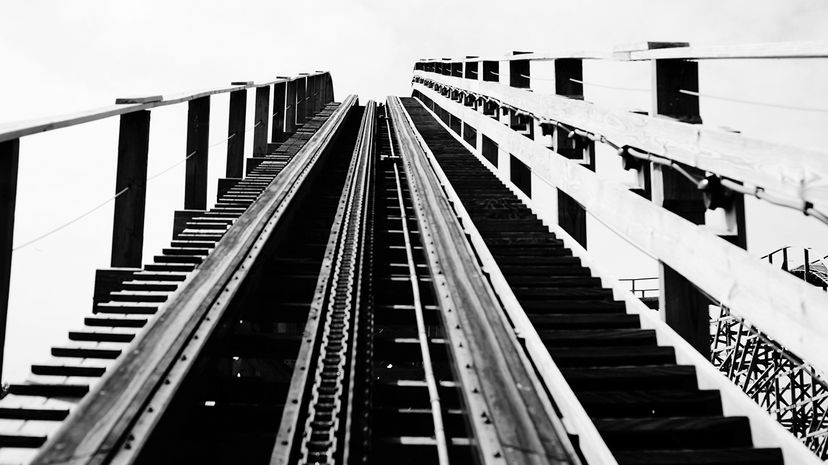Roller Coaster Components

At first glance, a roller coaster is something like a passenger train. It consists of a series of connected cars that move on tracks. But unlike a passenger train, a roller coaster has no engine or power source of its own. For most of the ride, the train is moved by gravity and momentum. To build up this momentum, the train has to get to the top of the first hill (the lift hill) or get a powerful launch.
Chain Lift
The most traditional way most trains get to that first hill is via a long chain (or chains) running up the hill under the track that simply pulls trains to the top. The chain is fastened in a loop that is wound around a gear at the top of the hill and another gear at the bottom of the hill. The gear at the bottom of the hill is turned by a simple motor.
Advertisement
The motor turns the chain loop so that the chain continually moves up the hill like a long conveyer belt. The coaster cars grip onto the chain with several chain dogs, which are mounted to the underside of the rollercoaster cars. Anti-rollback dogs prevent the train cars from rolling back if the chain breaks. They're also responsible for that "clack-clack-clack" sound you hear as a coaster train ascends the lift hill. Once the train cars reach the summit, the chain dogs release and the train starts its descent down the hill.
Catapult-launch Lift
In some newer coaster designs, a catapult launch sets the train in motion. There are several sorts of catapult launches, but they all basically do the same thing. Instead of dragging the train up a hill to build up potential energy, these systems start the train off by building up a good amount of kinetic energy in a short amount of time.
One popular catapult system is the linear-induction motor. A linear-induction motor uses electromagnets to build two magnetic fields — one on the track and one on the bottom of the train — that are attracted to each other. The motor moves the magnetic field on the track, pulling the train along behind it at a high rate of speed. The main advantages of this system are its speed, efficiency, durability, precision and controllability.
Another popular system uses dozens of rotating wheels to launch the train up the lift hill. The wheels are arranged in two adjacent rows along the track. The wheels grip the bottom (or top) of the train between them, pushing the train forward.
The Brakes
Like any train, a roller coaster needs a brake system so it can stop precisely at the end of the ride or in an emergency. In many roller coasters, there are also spots along the track where the train is slowed or stopped deliberately. This can be for safety reasons, such as where the train approaches the unloading zone at the end of the ride to prevent it from colliding with another train that hasn't yet departed, or through a steep curve. Track designers may also choose to slow down the train through a certain part of the ride to help build suspense for the riders. In roller coasters, the brakes usually aren't built into the train itself; they're built into the track [source: Birket].
Roller coaster designers refer to brakes that slow down the train as "trim brakes," and brakes that stop the train are known as "block brakes." In addition to these two main categories of brakes, there are also several different types.
The most common system is called a "fin brake,'' even though the fin is on the train car and the brake is on the track. A series of clamps is positioned at the end of the track and at a few other braking points. A central computer operates a hydraulic system that closes these clamps when the train needs to stop. The clamps close in on vertical metal fins running under the train, and this friction gradually slows the train down.
"Skid brakes" are most commonly found on old roller coasters and consist of long, ceramic-coated planks that rise out of the track and exert pressure on the bottom of the train to slow or stop it. There are also "magnetic brakes," which create a magnetic field between the track and the train that forces the train to slow down. Magnetic brakes are often used to complement other brake systems.